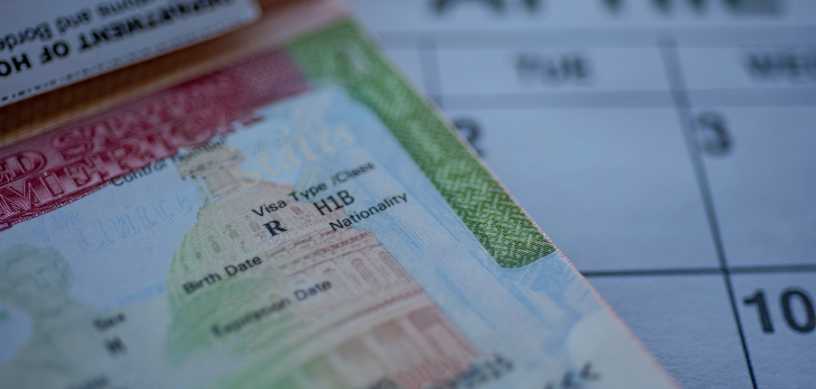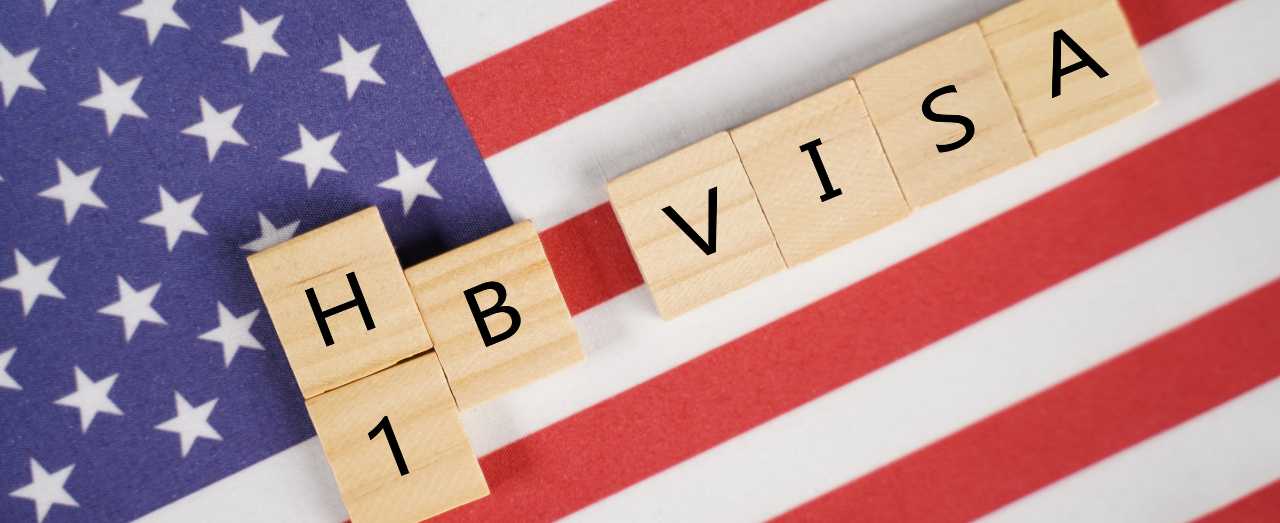Students who are planning to stay and work in the US, this recent H1B Visa changes 2025 bring in some of the most significant policy shifts in years. If you’re currently on an F-1 visa using OPT, or are considering the H1B visa after an F-1 visa, these new upgrades is what you absolutely need to understand.
What is H1B Visa?
The H-1B visa for international students is a type of non-immigrant visa in the United States that allows firms to hire foreign workers in speciality vocations, fashion models, and anyone working on Department of Defence projects who meet specified requirements. It is the US work visa for international students. The United States Citizenship and Immigration Services (USCIS), an organisation within the Department of Homeland Security, regulates and implements visa programs. Foreigners may hold H-1B status while in the United States, although they may not have a formal H-1B visa stamp.
Recently, on September 19, 2025, the President of the United States of America – Donald Trump signed a proclamation titled ‘Restriction on Entry of Certain Non-immigrant Workers’. This proclamation has been changed on multiple points. The abuse of the H1B visa program presents a national security threat by discouraging Americans from pursuing their careers in science, and technology, risking American leadership in these sectors. Henceforth, the US government imposed high costs on companies who seeks to use the H-1B program, in order to address the abuse of that program while still permitting companies to hire the best of the best temporary foreign workers.
Key changes in H-1B Visa 2025
- Restriction on entry: Starting from September 21, 2025, entry of specialty occupation workers under H1B category is restricted untill and unless employers pay an additional $100,000 fee.
- Scope of Restriction: This rule applies to H-1B visa for international students or workers currently outside the US and their petitions will not be approved without any proof of payment.
- National Interest Exemptions: The Secretary of Homeland Security may waive this requirement if employing such workers is deemed in the national interest and does not harm U.S. security.
- Employer Compliance: Employers are expected to submit documents of the payment before filing, and then both – Department of Homeland and Department of State will enforce compliance.
- Amending and Prevailing Wage rules: The Department of labour will revise prevailing wage levels, and DHS will prioritize high skilled and high paid H-1B applicants. This increases the impact of H-1B changes on students, especially on those moving from OPT or F-1 visas.
Impact of H-1B Changes on Students
The following changes in particular are meaningful for international students, OPT students, and for those who are planning for H-1B visa after F-1 visa transitions.
- Increased costs for employers may make companies more selective on whom they should sponsor. That can reduce chances for OPT students and recent graduates. Employers may likely prefer those with higher wages or skills that clearly justify the cost.
- OPT students who are hoping to use OPT as a bridge into an H-1B could find it more difficult. Since many OPT roles are starting-level or lower-paid, so meeting a higher wage thresholds and convincing employers to pay the extra $100,000 may be quite challenging.
- Students who are planning H-1B Visa for international students need to change their strategy for which employers to target, aiming for cap-exempt employers and positions with higher prevailing wages.
- Understanding whether your employer's petition will be subject to the $100,000 fee, as well as if your role clears the wage and skill requirement, it is critical for students considering the H-1B visa process, whether applying in the lottery or through consular processing following OPT or F-1.
What are the Exceptions?
- The additional charge does not apply to H-1B visa holders currently in the United States, nor to petitions filed prior to September 21, 2025.
- Money is only charged once for new petitions; renewals, extensions, or changes of employer (depending on whether they are considered "new" petitions) may not be subject to the $100,000 fee. This is currently being clarified.
- There may be national interest exemptions: in some situations, the US Secretary of Homeland Security may determine that hiring specific H-1B workers is in the national interest and waive the cost. It's unclear how often or to whom this will apply.
- Cap-exempt employers (universities, non-profit research institutes) may face different treatment.
Why are these changes been made?
- The purpose of these changes is to protect American workers by preventing firms from undercutting US salaries by hiring lower-paid foreign workers under H-1B. The policy seeks to tighten the system in favour of higher-wage and higher-skilled workers.
- Policymakers are concerned about program misuse, particularly by entry-level or outsourcing enterprises that exploit a high number of H-1B visas at low wages. Increasing fees and wage thresholds is viewed as one strategy to combat such abuses.
- The adjustments reflect a greater tightening of non-immigrant labour regulations under this administration, as part of larger immigration and visa policy developments.
What students should do?
- Plan early and stay informed: Always stay updated and track for the latest H-1B news 2025. Know the H-1B visa process for students as it will help to act quickly, especially if your employer is prepared to file before deadlines or exemptions apply.
- Strengthen your OPT Transition: If you’re currently on OPT, make sure your job aligns with prevailing wage levels, and your employer is capable of sponsorship. Securing an H-1B visa for OPT students requires financial commitment from your employer and proof of high-skilled employment.
- Choose high-skilled and high-pay roles: Since H-1B new rules 2025 prioritize high-skilled and high-paid workers, students should aim for roles like tech, research, healthcare, or engineering, in the industry. This will make the case stronger when moving from an F-1 visa to H-1B visa.
- Seek legal guidance: Consult with immigration lawyers or your university’s international student office. Expert advice is important for navigating the impact of H-1B changes on students and ensuring that your employer’s petition complies with the new requirements for a US work visa for international students.
Conclusion
The H-1B visa changes 2025 have reshaped the pathway for international students who aspire to work in the U.S. With higher costs, stricter wage rules, and tighter entry restrictions, securing an H-1B visa after F-1 visa or during OPT will require careful planning, informed choices, and strong employer support. While the impact of H-1B changes on students may feel complicated but staying updated on the latest H-1B news 2025, targeting the right opportunities, and seeking proper guidance can still make the dream of obtaining a US work visa for international students achievable.

FAQs - H-1B Visa Changes in 2025
What is the new rule for H-1B visa?
H-1B new rules 2025 introduces a mandatory $100,000 fee for new petitions filed for workers outside the U.S., along with high prevailing wage requirements.
What are the latest H-1B visa changes in 2025 for international students?
The latest H-1B news 2025 confirms that the employers are expected to pay $100,000 fee for new petitions and comply with stricter wage levels. This change largely affects the H-1B visa for international students who are seeking jobs after graduation.
Can international students on F-1 visa apply for H-1B in 2025?
Yes, students on an F-1 can still apply for an H-1B visa after F-1 visa, but their employers should be willing to meet the new financial and wage requirements.
How does the $100,000 H-1B fee affect recent graduates and OPT students?
This new fee structure makes it harder for small companies to sponsor, which affects the H-1B visa for OPT students and fresh graduates.
Is the interview waiver still available for H-1B applicants in 2025?
Some applicants may still qualify for interview waivers, the H-1B visa process for students is stricter, and more cases are likely to require in-person interviews. This depends on consular discretion under the H-1B visa changes 2025.
What is the process for transitioning from F-1 to H-1B visa in 2025?
The transition process involves securing an employer to sponsor willing to file under the H-1B new rules 2025 and paying the required fees. Students must also ensure their OPT or CPT aligns with the H-1B visa process for students.
Are STEM OPT students eligible for H-1B under the new rules?
Yes, STEM students on OPT can apply, but the impact of H-1B changes on students means that only firms willing to pay the $100,000 price and offer better compensation are likely to proceed. This has a substantial impact on OPT students' H-1B visas.
When should international students apply for H-1B in 2025?
Students should apply during the lottery window, which usually opens in March. However, they should take into account the H-1B 2025 revisions, which increase the fees for applicants from outside the United States. Making plans in advance guarantees that overseas students can navigate the US work visa application process more easily.
How have H-1B lottery chances changed for international students?
Lottery system remains, but the changes in H-1B visa policy prioritize higher-paid roles. This shifts opportunities, making the H-1B visa for international students more competitive than before.
Do international students need work experience to get H-1B in 2025?
Although the work experience is not mandatory but the H-1b visa is now more favourable for the students with specialized, high-skill roles. Strong credentials reduce the impact of H-1B changes on students.
What documents are required for students applying for H-1B in 2025?
Documents such as valid passport, degree certificates, I-20 forms, OPT authorization, and an employer’s petition. Under the H-1B visa process for students, employers must also provide proof of the $100,000 fee payment per the H-1B new rules 2025.
Can students apply for H-1B without a job offer in 2025?
No, one cannot apply without a job offer because the H-1B visa for international students requires employer sponsorship. Without an offer, you cannot participate in the H-1B visa process for students.
How do H-1B policy changes impact Indian students in the US?
A significant portion of applicants are Indian grads so the effects of the H-1B amendments are particularly felt by these students. The H-1B 2025 revisions increase the likelihood of success solely for high-paying, in-demand positions.
Is it harder for international students to get H-1B in 2025?
Yes, the increased employer costs and pay requirements brought about by the 2025 H-1B visa modifications make it more difficult. However, there are still good chances for international students to obtain a US work visa for specific positions in STEM and research.
What are the common reasons for H-1B rejection for international students?<
Under the H-1B new regulations 2025, rejections frequently occur due to inadequate income levels, employer ineligibility, or missing documentation. OPT students' H-1B visa is especially at risk if employers are unable to comply with the new regulations.
Are there alternative work visa options if H-1B is denied in 2025?
Yes, there are options such as O-1 visas for extraordinary ability, L-1 visas for intra-company transfers, or one can even continue on STEM OPT. These options provide backup pathways for a US work visa for international students if the H-1B visa after F-1 visa route is unsuccessful.






